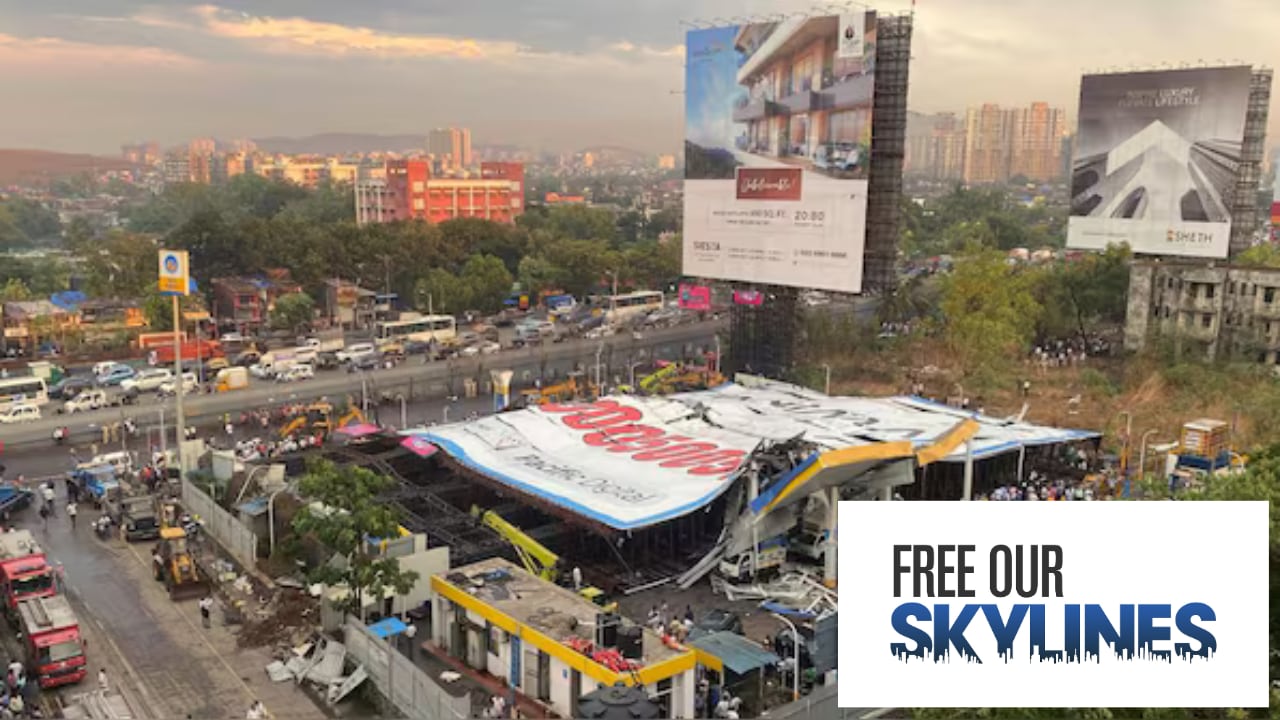In addition to casting doubt on the accountability of the railways and the Brihanmumbai Municipal Corporation (BMC), the tragic hoarding accident that occurred in Mumbai on Monday served as a wake-up call for the brands that frequently opt out-of-home (OOH) for promotional activities. While BMC has threatened license revocation for Ego Media (media agency) over the illegal hoarding that killed 14 and injured over 70, many believe the issue with illegal hoardings is the country seems to be enlarging.
Consider this: The illegal billboard in question was roughly 120×120 feet—nearly thrice the permitted size of 40×40 feet. It should be mentioned that the BMC reports that there are ‘only’ 1,025 legitimate hoardings in the nation’s financial capital, which is considered the hub for OOH industry boasting of around Rs 700-1000 crore market and is the 2nd most populated city in India.
Therefore, to safeguard their own reputation and, to an extent, help curb illegal hoardings in the country, experts have urged brands to be cognizant of their OOH partners and vendors.
“Especially after this incident has come to light, brands will now have a responsibility to ensure that they check the bona fide credentials of the vendors; after concessionaire as well as on the site itself because once an accident like this happens, the brand on the banner gets all the negative publicity. Therefore, not only from an ethical point of view, but it’s also in the interest of a brand from a pure commercial point of view that they need to be more vigilant,” said Samit Sinha, managing partner, Alchemist Brand Consulting.
He advised brands to ask for the papers that establish the bona fide credentials of that particular site and suggested they do due diligence. Given India’s out-of-home (OOH) advertising industry is highly fragmented and unorganised and with the unorganised segment dominating the market, it is prone to a lot of loopholes. “Because of the nature of the business, you have to be extremely vigilant, extremely mindful and extremely diligent,” he added.
That apart, the hoarding market is not as strictly and tightly regulated as it ought to be. Currently, laws regarding hoardings are governed by state governments, with no centralised regulations. Therefore, to address these issues, there is a need for comprehensive national safety laws, highlighted experts.
The infamous ad scam that shook Bangalore in 2016 revealed revenue losses of up to Rs 2,000 crores due to the Bruhat Bangalore Mahanagara Palike (BBMP) turning a blind eye to illegal hoardings erected in the city. It also noted as many as 4,000 hoardings out of over 6,000 were illegally erected in the metropolitan city.
Unfortunately, said experts, there will always be unscrupulous players and there could be unscrupulous brands as well. Sometimes hoardings are so strategically located that attract maximum eyeballs, unscrupulous brands/agencies have the temptation of overlooking the legality. As per an industry insider, BMC charges approximately around Rs 80 crores as license fees from the advertising billboards in a month.
“Sadly, what happens in this country is that very soon it all is forgotten and forgiven. So therefore, the big established brands have a responsibility not just to society but also to themselves, to do a thorough check before getting tempted,” Sinha added.
Ramesh Narayan, Founder, Canco Advertising, added that responsible advertisers should now make it mandatory that outdoor site owners sign a declaration that every government regulation has been adhered to by them, and no deviation has been made. Highlighting how the legal declaration should be mandatory, he added that industry specific associations like the ISA and AAAI should lead this effort.
“Our country has enough laws and more. It needs enforcement and there should be a way to demand accountability from all public servants. The neta-babu nexus has been very detrimental to the country. Brand marketers should take all steps to show that they are not like the rest of the public servants. They operate commercially so they can demand accountability from their vendors and agents,” he said.
Read more: Mumbai “illegal hoarding” collapse; BMC to take legal action against ad agencies
Himanshu Arora, Co-founder, Social Panga, begs to differ. According to him, brand marketers have limited influence over the control of illegal hoardings since they do not manage the entire dissemination process. This responsibility typically falls under the authority of bodies like the BMC, as demonstrated in the recent case. “Regular structural audits should be conducted to prevent such incidents. Despite the India Meteorological Department (IMD) Mumbai issuing a thunderstorm warning, there are ground-level issues that need to be addressed,” concluded Arora.
#FreeOurSkylines – Fight against illegal ad hoardings: A terrible tragedy struck on May 13 after a 100-foot-tall illegal billboard fell at a petrol pump in Ghatkopar during dust storms and unseasonal rains in Mumbai. The killer hoarding caused the deaths of over a dozen people and injured many others. The catastrophic incident outraged citizens who have been dealing with the menace of illegal ad hoardings. The people don’t want just answers but solutions, as they turn to civic authorities, advertising agencies, industry bodies, brand marketers, and media owners, to take responsibility and fight against the menace of illegal advertising hoardings. So speak up and join the #FreeOurSkylines movement. Write to us at Storyboard18@nw18.com with your concerns and views, and let’s make our cities safer together.
